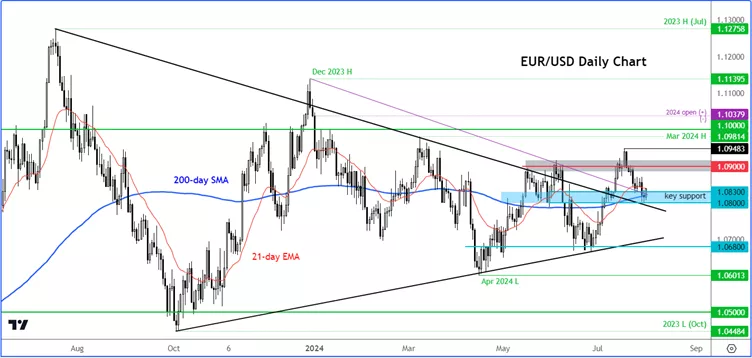EUR/USD: Focus Turns To FOMC After Stronger Eurozone CPI
Image Source: Unsplash
The EUR/USD pair will remain in focus heading into the second half of Wednesday’s session and the week. This morning's stronger-than-expected Eurozone CPI release has made a potential September rate cut from the ECB a closer call, easing pressure on the euro. The euro gained against most major currencies, except the yen, which surged after the Bank of Japan's unexpected 15 basis point rate hike.
As we enter the second half of the session, attention shifts to the US side, with the FOMC's policy decision at 19:00 BST. A dovish surprise from the Fed could bolster the EUR/USD slightly. The dollar might weaken further as we progress into Q3, with the Dollar Index showing a small loss for July, partly due to a rebounding yen. Declining US bond yields and rising expectations of Federal Reserve rate cuts could lead to a stronger euro and pound against the dollar.
FOMC and NFP among Key Events for EUR/USD This Week
This morning's slightly stronger Eurozone inflation data and weaker US ADP private payrolls report has provided a boost to the EUR/USD. The focus will be on the US dollar moving through to the rest of the week. Today's FOMC rate announcement and Friday's July jobs report are among the key events on the US economic calendar this week.
FOMC Could Signal September Cut
The Fed is expected to keep policy unchanged at today's FOMC meeting, with the market implying a high probability of a hold. However, a September rate cut is now fully priced in, and further dollar weakening will depend on how dovish the Fed's future policy stance appears.
Recent statements from Fed officials and weak US economic data, such as a rise in the unemployment rate to 4.1% and a drop in CPI inflation to an annual rate of 3.0%, suggest current monetary policy may be too restrictive. The Fed may adopt a more dovish tone to avoid unnecessary economic strain, aligning with the global trend towards policy easing (excluding Japan).
Market expectations point to 65-70 basis points of cuts by the end of the year. If the Fed or Chairman Jerome Powell confirms a dovish approach at today's FOMC meeting, predictions might increase to as many as three cuts before year-end, potentially weakening the dollar.
US Employment Indicators Could Determine Pace of 2024 Cuts
The Federal Reserve's dual mandate to achieve maximum employment and stable prices means inflation isn't the sole focus, especially with CPI easing towards the 2% goal. The recent uptick in the unemployment rate highlights labour market softness. This places importance on Friday's US non-farm jobs report. Economists predict 177,000 net NFP job gains for July, with the unemployment rate steady at 4.1%. If the unemployment rate rises or job growth slows, expectations of three rate cuts by December could be reinforced, weakening the dollar and supporting the EUR/USD. Conversely, stronger US employment data could pressure the EUR/USD.
Eurozone CPI Comes in Hotter
Today's Eurozone inflation data showed a slight price uptick. The year-on-year increase in the Harmonized Index of Consumer Prices (HICP) rose to 2.6% in July from 2.5% in June, above the 2.5% consensus forecast. Core inflation, excluding volatile items like energy and food, held steady at 2.9%, also exceeding expectations.
Energy inflation increased to 1.3%, but the ECB's focus is on services inflation, reflecting domestic economic conditions and sensitive to wage changes. Services inflation dipped slightly to 4.0% from 4.1% in June, but remains high, likely keeping ECB policymakers vigilant.
Even if European inflation declines faster in the coming months, its impact on the euro is uncertain. Much of the downside risk from declining confidence indicators and weak Eurozone economic data is already priced in. Economic data would need to deteriorate sharply for the euro to weaken significantly. Today's German job market data showed an unexpected 18,000 increase in unemployed Germans in June, and German import prices unexpectedly rose by 0.4% month-on-month, increasing inflation risks.
EUR/USD Technical Analysis and Trade Ideas
(Click on image to enlarge)

The technical outlook for EUR/USD is slightly bullish, influenced by the recent decline in US bond yields and rising expectations of Fed rate cuts. A dovish Fed stance and weakening US job data could push EUR/USD higher, breaking more resistance levels. However, it is worth being ready for any outcome.
The 1.0800 to 1.0830 range, where EUR/USD has been hovering, is a key support zone. This area is significant due to the convergence of two broken trend lines from December and July 2023, with the 200-day moving average positioned in the middle.
If EUR/USD fails to hold within this range, a deeper correction towards the low 1.07s could occur. However, if bullish momentum returns as anticipated, the pair might initially target the 1.0900 resistance level, with 1.0950 as the next potential stop.
More By This Author:
Gold Maintains Bullish Trend Ahead Of Busy WeekFX Update: Euro Struggles As Yen Surges Amid Weak Eurozone PMIs
Gold's Drop Could Be Yet Another Bear Trap




